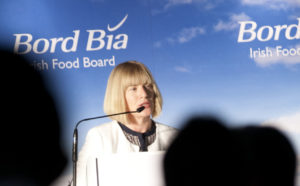Pubs and the radical route

“The standard traditional restaurants are now investing in the grab-and-go market. What’s to say pubs can’t have something out front, for example coffee-to-go and/or other things?” – Maureen Gahan.
With Brexit bearing down, the importance of the UK to the Irish pub tends to focus on UK tourist numbers.
“Tourists account for a big part of out-of-home spend and figures show that while numbers are flat spend is down” says Maureen Gahan, Foodservice Specialist with Bord Bia and author of its annual Foodservice Insights report, just published.
“What used to be 8-10% growth in overall tourist numbers a year saw just 2% growth this year to the end of September, but within that GB is flat. Spend by GB consumers is down per head according to the trade – whether that’s something to do with Sterling or simply these tourists spending less.”
And any industry caution that’s out there will also be because of a fear of extra costs being introduced into the supply chain as a result of Brexit, she feels.
“It’s more worrying for Food & Beverage suppliers who export to the UK than for the Irish Hospitality industry” she believes, “but the knock-on effect of any hit to exports could result in job losses down the line in 2020 or 2021 where it might have a real effect on Ireland’s GDP and growth rate if unemployment begins to hit in.”
DIT graduate Maureen holds a BSc in Management and joined Bord Bia in 2001 as a Trade Marketing Specialist. She’s held responsibility for managing Bord Bia’s Foodservice programme on the Ireland market since 2009 and her role includes developing relationships with Trade Buyers and identifying potential opportunities for Irish food and drink manufacturers. Prior to joining Bord Bia she worked with the Trade Development Institute in Dublin, a seafood importer in Paris and with Enterprise Ireland in its Stockholm office.
Potential for everyday foodservice occasions
Her report shows that domestically everyday foodservice occasions continue to drive growth and are less likely to be affected by changes to consumer sentiment.
“Everyday foodservice occasions are not the same as pleasure-based occasions such as the pub,” she explains, “But while pubs may eventually be affected, these everyday foodservice occasions are currently part of our everyday habit. If you look at the effect of the increase on VAT rates in Hospitality, prices have gone up but to a certain extent a lot of that has not affected day-to-day consumer behaviour.”
But if we do end up in a recession – and nobody’s predicting that at the moment – then there may be a downturn but it’s unlikely in the next 12-18 months, she believes.
“Within our lifestyle eating out-of-home has become part of what we do on a daily basis. Our habits have changed and so this is unlikely to be affected as consumers will still be able to afford everyday items like coffees.”
Uncertainties & cautionary tones
But uncertainties and cautionary tones have begun to appear as we head into 2020: people are still dealing with Brexit and VAT uncertainty in trying to remain competitive in Hospitality.
“The macroeconomic indicators are still strong though,” she points out, “Dublin Airport had three million passengers in September, the busiest month ever. October passenger numbers are up too, so there’s wealth still in the economy. And while there’s still a real split between Dublin and the rest of the country, projecting forward, there seems no obvious sign of slowdown in Dublin.”
Right now facebook is building new offices in Ballsbridge for 7,000.
“Research from September on Irish households indicates that they have 50% more income than in the UK” she adds, “so all the indicators suggest a certain amount of wealth.”
Pubs – poorest performing foodservice channel
Nevertheless pubs remain the poorest performing foodservice channel in the report, predicting growth of just 1.8% from 2020-2022.
Traditional restaurants, on the other hand, will see growth of 4.2%, on par with overall growth.
“Pub numbers are going to shrink and pubs in rural Ireland who cannot afford to change will close.
“There are also just too many traditional pubs in the country,” she says, “Add to that the drink-driving issue and changing consumer behaviour will undoubtedly shrink this further.
“While pubs are still going to grow slightly the warning signs are there that it’s going to grow a lot slower than overall foodservice growth,” she warns.
“The ones doing well are those adapting with food-to-go, for example.
“Retailers such as Dunnes Stores are trying to get into food-to-go. They see that this is where the money is. Pubs need to be more flexible. A lot of them are now standing as food outlets and coffee shops. Pubs are ideally set-up in terms of layout and that third space for people. They should have good WiFi and a good food offering.”
Suburban or neighbourhood pubs are looking to be a space for event organisations too.
“Food-to-go, foodservice occasions and also the ‘experiential’ or social appeal of the pub should be utilised,” she believes, “In food, consumers want a much more casual service and pubs can fill this need. Food trucks etc are regarded as something cool and funky that can be shared on Instagram.”
To her there’s little doubt that ‘wet-houses’ will continue to shrink.
Home delivery phenomenon
RoI consumers will spend €6.32 billion on out-of-home food & (non-alcoholic) beverage this year, an increase of 4.5% on last year.
But as we experience increasing population numbers technology is driving the home delivery phenomenon. Younger consumers expect to be able to demand here and now what they want today.
In the US 50c of every dollar is spent out-of-home. Here in Ireland that figure is 33%.
“The pendulum is likely to swing more towards the US out-of-home ratio and that’s driving the market along with all the other positive macroeconomic indicators.
“We’re in relatively ‘boom times’, unlike the UK.”
Deliveroo in the UK and other markets now has dedicated ‘restaurants’ in areas where no restaurants exist to service demand for a foodservice offering.
Growing demand for non-alcoholic on-trade options
Few will have missed the growing demand for non-alcoholic options from pub-goers and while Maureen agrees it’s growing fast, it’s doing so from a small base, she says.
“It ties into the whole health & wellness thing. We’re seeing it in other countries too.
“This will continue to grow,” she predicts, “Non-alcoholic drinks are recognised now as not just being a fad, especially as they taste much better today.”
‘Pleasure-related occasions’ of profit
Bord Bia conducted in-depth interviews with 14 consumers and found that pubs were used by one-third of them between two and six days per week whereas just under one-third (27%) used pubs just once every two to three weeks.
Just over one in 20 used pubs just once a month and just under one-third (27%) tended to use pubs only once every two or three months. Just over one in 20 never used pubs.
The Insights report finds that consumers today articulate a different decision-making process and value equation for ‘pleasure-related occasions’.
Consumers tend to be less price-sensitive on pleasure-related occasions like the pub outside the routine of everyday life. In contexts like ‘date-night’, carefree spending becomes a part of how consumers differentiate these experiences to take a break from ‘real life’.
Consumers cite a tendency to stick to the same operators for indulgent occasions as they tend to be more reliable and pose less of a risk when it comes to ‘return on investment’.
“What you’re seeing there comes back to daily foodservice occasions where convenience stores and coffee shops are more likely to get this customer where pubs and restaurants are more likely to see action on a weekly basis as a higher transaction spend is anticipated,” she says, “It’s not dissimilar to full-service restaurants.
“The big ones coming out on 2-6 days a week are convenience stores, quick-service restaurants and petrol stations.
“Coffee shops top this so almost half visit coffee shops daily.”
Pubs should accept that they’re in the ‘experiential’ and ‘human interaction’ market, “They should concentrate on higher unit spend if only being visited once a week,” she suggests.
The question is, is there any role for pubs to play in day-to-day hospitality?
Maureen Gahan believes so.
“The standard traditional restaurants are now investing in the grab-and-go market. What’s to say pubs can’t have something out front, for example coffee-to-go and/or other things?”
She’s also encountered the idea of sharing different operations in a single outlet to help with high rental costs.
“In Japan three different restaurateurs work separately over 24 hours in one premises – for example one offers coffee in the morning, another noodles in the afternoon and in the evening there is an alternative restaurant menu.”
Should the pub trade worry?
Not if it can adapt.
But some pubs will need to adapt much more radically than others.

Pubs need to be more flexible. A lot of them are now standing as food outlets and coffee shops. Pubs are ideally set-up in terms of layout and that third space for people. They should have good WiFi and a good food offering.”









